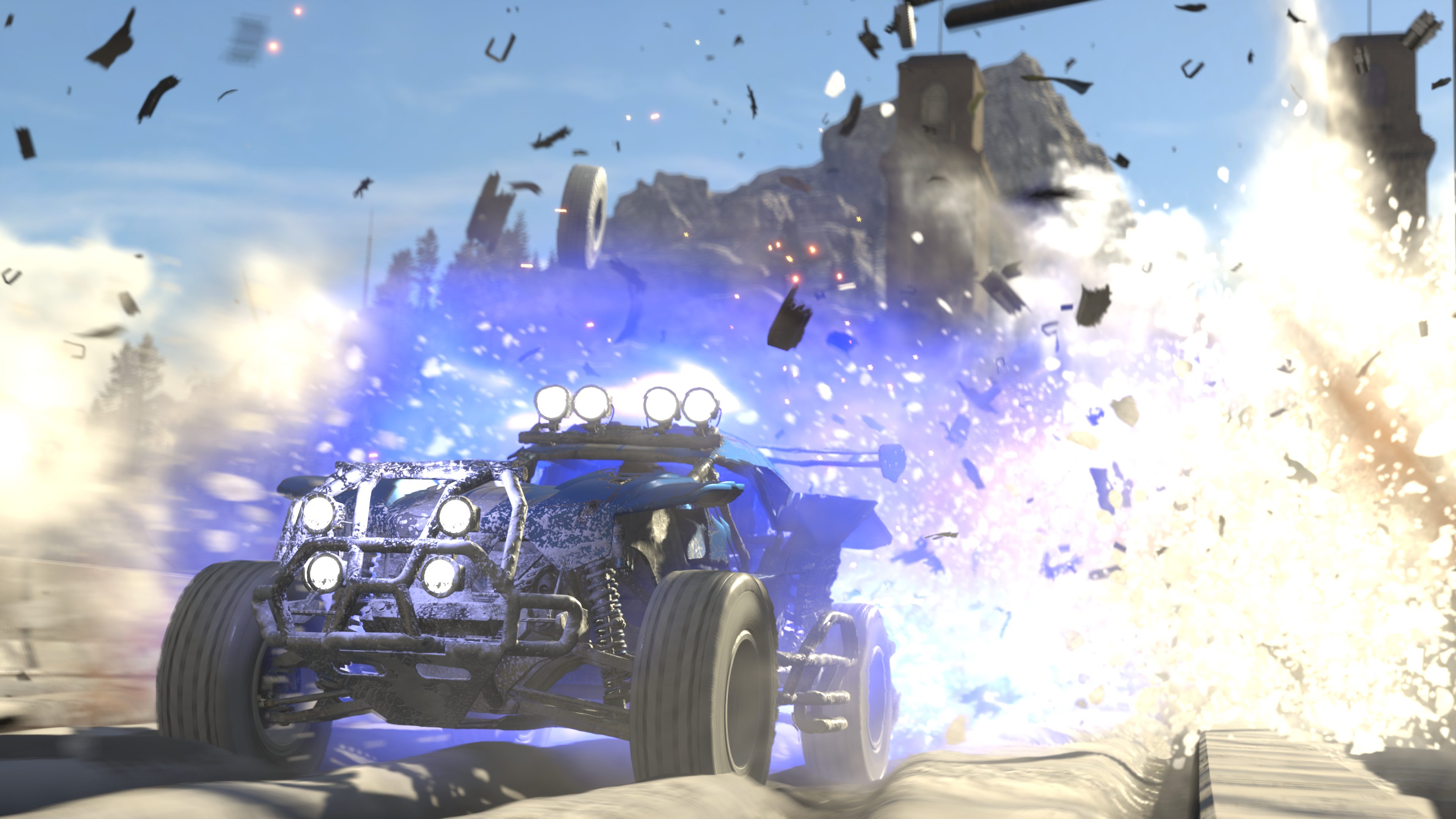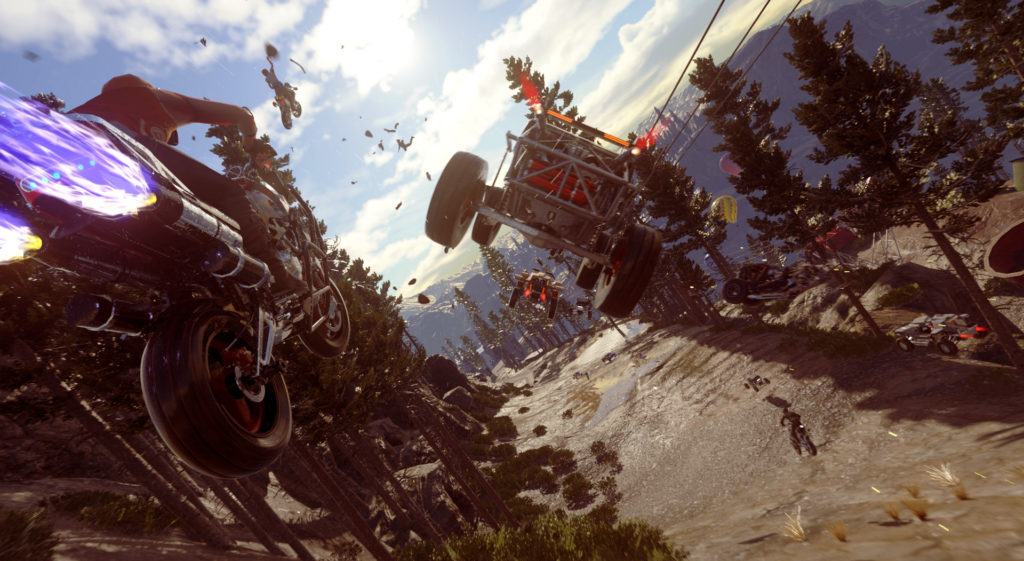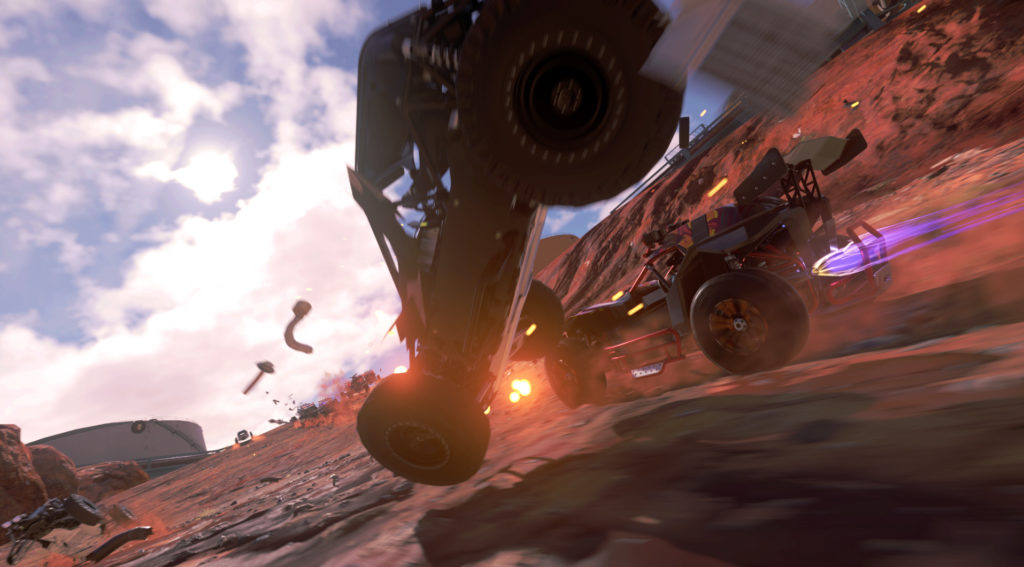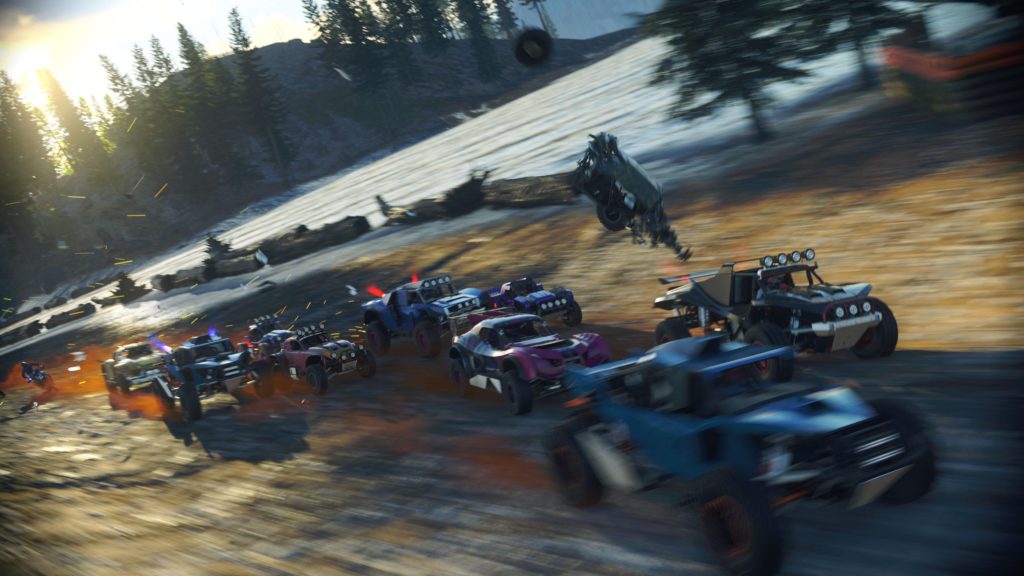It’s been a while since the reign of the arcade racing game. It may be hard to notice in today’s shooter-dominated landscape, but the genre has continued to quietly evolve since the early 2000’s when some risk-taking ideas were just coming to the forefront. Need For Speed, Midnight Club, and Project Gotham Racing all set the standard for over-the-top racing on the tarmac, but elsewhere, the genre was just trying on a brand new set of wheels.
Burnout for one, would go on to take the least desirable part of a race–the crash–and make it a focal point of its gameplay. Another standout of the time, Blur, would fuse street racing with Mario Kart-style pickups. Split Second and Motorstorm: Apocalypse would turn the tracks themselves against its racers. Sadly, one by one, each of these titles would eventually succumb to the winds of change, and whole franchises were left to stagnate. Years, and several resolution upgrades later, there are still racing IP’s keeping hope alive in this gaming generation, thanks to the efforts of developers like Playground Games, and Codemasters.
This brings us to Onrush, Codemasters’ latest salvo in the continuing quest for genre elevation. Over the past decade, Codemasters has been on track with near-annual releases, all the while tweaking their various formulas to perfection (Their last title, DiRT 4, for instance, had procedurally generated tracks). The difference this time is that after acquiring Evolution Studios, the studio behind Motorstorm, the sky was the limit on what Onrush could become. The answer, as we would find out a year after this acquisition, is a genre-breaking hybrid that fuses the best parts of battle racers and modern-day hero shooters. The game has some inspired ideas and is a load of fun, plus it managed to send me on a trip down memory lane, all the way back to the arcade racers of yesteryear.
Stil, it’s clear from the onset what Codemasters set out to achieve here.
We’re in an age of massively multiplayer games, and games-as-service dominating the sales charts. Games like Rocket League, Overwatch, and Fortnite are built around accessible concepts that have loads of competitive, strategic appeal, and progression loops that engage and incentivize people to earn (or purchase) cosmetic items. Onrush tries to incorporate all of these elements at once by not only having a diverse roster of characters to play as, but eight different vehicle types for them to drive, each with their own attributes to learn and master. If you still aren’t convinced, a quick look at the main menu should just about do it. You will immediately feel a sense of familiarity, as it’s nearly an exact copy of your favorite hero shooter, down to the labyrinth of customization screens enthusiastically letting you know which skins, taunts, and tombstones (think stickers) you don’t own.
The various customization menus are so dense in fact, that the “Play” option only being split among a sparse four modes is a bit baffling. Here, you can choose between a campaign that can be played solo or with a friend, a quickplay list that hurls you straight into continuous 6v6 online multiplayer, and a custom option that lets you set up offline races, for some reason.
You’ll notice I said four, but only listed three. That’s because at the time of this writing, even after having waited three weeks after release to post this review, the “ranked” playlist still isn’t available. It is quite perplexing that a game with competitive aspirations chose not to cater to that very crowd at launch, to say the least.
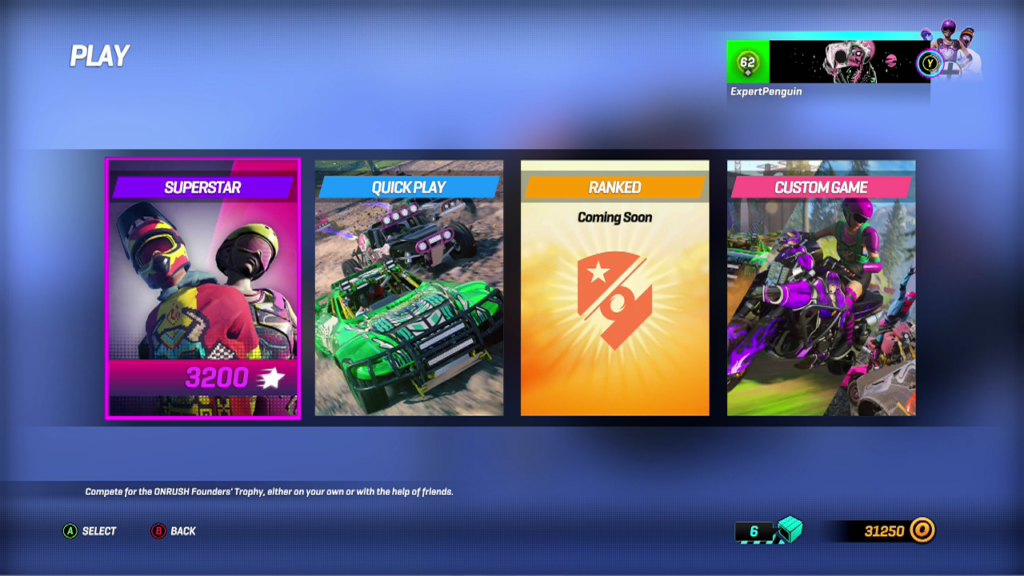 Why? Also how? Also, WHY?
Why? Also how? Also, WHY?If the moment-to-moment gameplay weren’t so finely tuned, it could’ve been a complete disaster. Onrush initially defied my expectations by playing like a fusion of Burnout‘s battle-heavy racing, SSX‘s gravity-defying jumps, and the team-based dynamics of Overwatch. While the first two are more or less on the money, with the weighty, relentless feel of the driving inching closer to Motorstorm than Need for Speed, it’s the game’s team-based focus that sets it apart.
You see, the point of Onrush isn’t to “win” by crossing the finish line first, or making the best lap time. The standard arcade racing techniques where you as the player are better served by positioning, cornering, and outracing your opponents, don’t apply here. Instead they are replaced with the need to outplay your rivals by way of racking up points to win rounds. Since the game’s default setting is always based around 6v6 battle racing (with “fodder” dummy vehicles peppered throughout to encourage endless boost), progress rests heavily on how players go about crashing into one another, not the fact that you can crash into one another. Each vehicle is fitted with a unique ability, and the effects vary from passive, like stealing a rival’s boost, to actively throwing down barriers that disorient and stifle movement.
Those powers will and do come in handy over the game’s four basic play types within each mode. Starting from the top, Overdrive asks you and your team to boost as long as possible to maximize your points before the round’s close, which does make mastering the finer points of how you earn boost a necessity. Countdown sets up slalom-like gates to drive through, which is exactly as fun as it sounds, trying to hit precise points in a high speed offroad game. Switch and Lockdown are the more creative of the four, with the former playing out like a Team Deathmatch, forcing a vehicle change after every wreck, and the latter playing out like a zany version of King of the Hill built on inertia.
It was Lockdown that I personally looked forward to during each session, as it felt the most unique of the four play types, and captured what I feel is the game at its absolute best. There’s a genuine sense of tension and white-knuckle intensity that ensues as the balance between maintaining speed, and staying alive teeters precariously around the fact that you have to capture a zone while driving. Onrush is selling itself on offering a unique kind of racing experience, and the game rarely leans into that uniqueness with the kind of conviction this mode offers. Capturing zones and driving really fast are things you can do in any racer. A mode like Lockdown is special. It’s honestly great stuff, and more than any other gametype, it provides those rare moments that force you to play the game to its strengths.
In fact, that sentiment of wishing the game lived up to it’s potential is why I can’t soundly recommend it to anyone at its current asking price. No matter how fun the game is in the moment, it doesn’t change the fact that you can see everything the game has to offer in literally one session. The single-player and multiplayer blend into an indistinguishable soup, and unless you need a tutorial for the multiplayer, it serves little purpose in the grand scheme. The opportunity to craft a unique backstory for the game’s colorful cast, or offer an experience unique to the endless loop of Quickplay is lost. The opportunity to craft a compelling multiplayer is off the table, as the game doesn’t support split screen offline, or co-op for more than 2 players.
Eventually, the inherent lack of variety will start to set in, and threaten to rot players attention span the longer the play sessions in online Quickplay mode go. Somehow, for a battle racer whose engine can support up to 24 vehicles onscreen at any given time, Onrush manages to do the impossible and make nearly every play option feel the same, no matter which of your two play options you indulge in. Do you want to play the game entirely at random? Play Quickplay. Do you want a semblance of structure and the illusion of choice? Play the campaign. It’s the only real difference.
This makes progression within the game, the only leg the game has left to stand on for a decent shelf life, feel like a mixed bag. Playing races earns you medals that the game turns into experience, and you earn one “Gear Crate” every time you level up. Yes, Gear Crates, and you surely guessed it, these are indeed Onrush‘s version of loot boxes. In fact, they’re the only reward for EVERYTHING you do in the game. I suppose it’s a saving grace that there is no way to purchase these loot boxes, but it doesn’t stop them from feeling any less gross, as things stand today.
This seemingly generous gesture of unmonetized loot boxes presents a huge problem with the way this game handles rewards, however. With every unlockable item in the game connected to these loot boxes, and the rewards being entirely cosmetic, the fact that you can’t purchase them seems stranger than being able to in the first place. After several underwhelming crate openings, I began to see it as entirely possible that the game at one point DID have microtransactions, and Codemasters might’ve gotten a case of cold feet, given the current climate.
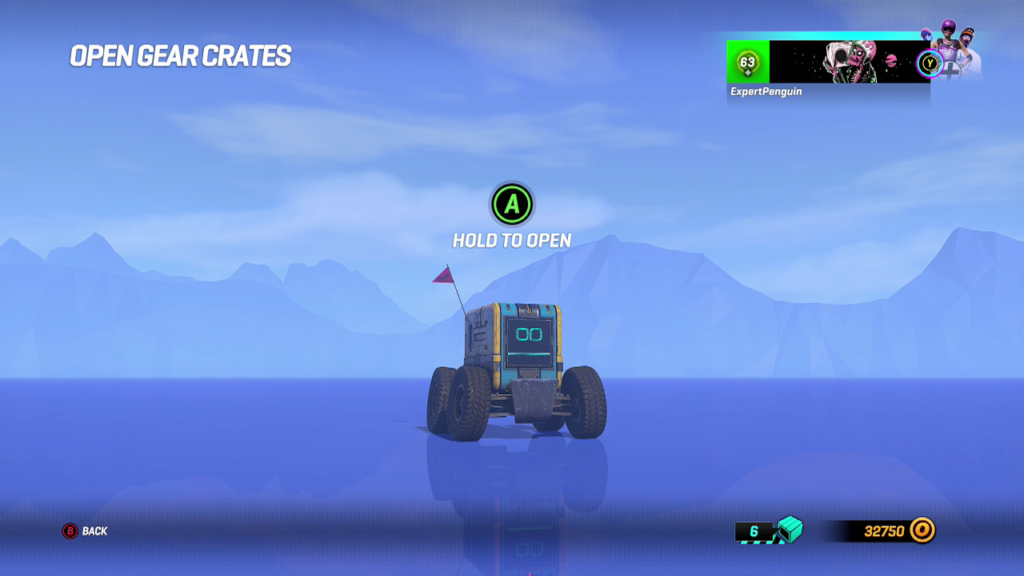 KNEEL BEFORE YOUR MASTER.
KNEEL BEFORE YOUR MASTER.
Allow me a moment to drive my tinfoil car: It’s entirely possible, that in the two or so years that this game was in development, Evolution studios seeded the idea for Onrush as a free-to-play (or at the very least budget priced) title that would recoup costs through microtransactions. After all, titles like Paladins, Warframe, and eventually Fortnite would do the same thing to find success, so why not? Provide a polished, fun experience that people will want to pay for, and they will pay for it.
However, after EA practically demonized and vilified the very idea of loot boxes the same year with Star Wars Battlefront 2, I think those plans ground to a screeching halt. I’m going to speculate here, and say that Codemasters went into panic mode as the ire of gamers everywhere echoed around the web in late 2017.
Maybe, an unproven game concept, starting up a new IP, and being financed by microtransactions didn’t sound like such a good idea, after all. It’s very likely that all monetization was ripped out of the game, and tied to the experience/coin system instead in a last-ditch move. The game thus received a full price tag in an attempt to make whatever they could back from whatever sales the game could achieve, and the early adopters become the proverbial test dummies in the process.
But that’s again, just speculation on my part.
Onrush, in the end, isn’t disappointing solely because of its flaws, but because it didn’t have to release with the ones it has in the first place. The game is fun, but everything surrounding it conspires to hold it back. From its unfinished feel that seems to have prioritized meeting a release window over polish, to the lack of diverse modes, to the somewhat unreasonable price tag of $49.99 (a recent drop — price at launch was $59.99), Onrush seems like a game that Codemasters was reluctant to release, much less support post-release. It’s an unfortunate sacrifice of an inspired concept, with a bonus lingering feeling that with just a bit more attention, this game could’ve been every bit of fun that it thinks it is.
Unfortunately, after nearly three weeks of running the same races, in the same modes, with very little in the way of rewards or meaningful progression to tie it all together, the impression that the entire playerbase is just figuratively, literally spinning their wheels is hard to deny. With the developer being mum on how the game will grow, or improve in the near future, you’re left with a game that is at its best, an exciting, exhilarating, occasionally frustrating addition to the genre that sets a wonderful foundation for itself.
At it’s worst, however, it feels like a great game sent out to die.
(Xbox One version reviewed)

